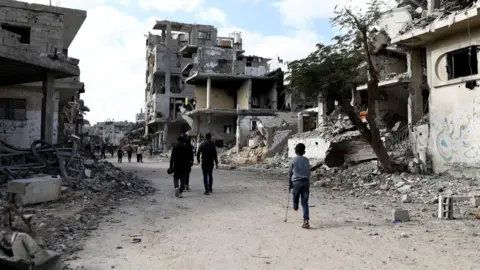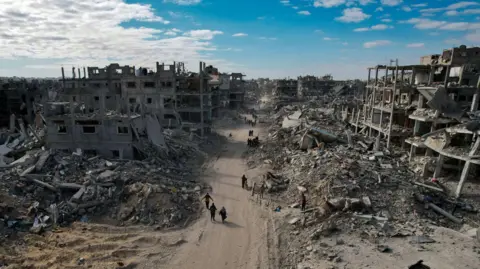Gaza hunters consider it a scale of destruction.
 Reuters
ReutersOn Monday, Gaza’s first full day of peace, rescue workers and civilians began to assess the extent of the devastation to the Strip.
Gaza’s Civil Defense Agency – the main emergency response service for the looting – fears more than 10,000 bodies are still buried under a sea of rubble.
Spokesman Mahmoud Bassal told the BBC that they hoped to rescue the dead within 100 days, but said they could be delayed by a lack of bulldozers and other essential equipment.
Following Sunday’s cease-fire, new images from Gaza show the devastation wrought by 15 months of Israeli aggression, particularly in the northern part of the territory.
The United Nations has previously estimated that 60% of buildings around Gaza have been damaged or destroyed.
While the sounds of bombing were replaced by celebrations as the cease-fire began Sunday, the reality facing people around Gaza is depressing.
According to the UN’s World Food Program (WFP), the war has left more than two million Gazans homeless, without income and completely dependent on food aid for survival.
That aid began flowing into Gaza immediately after Sunday’s cease-fire, and the United Nations said at least 630 trucks had entered the canal before the end of the day – the highest number since the war began 15 months ago.
Sam Rose, acting director of Urwa, the United Nations refugee agency in Gaza, said the aid offer was the start of an effort to bring the strip back to life.
“We are not only talking about food, health care, buildings, roads, infrastructure, but we have individuals, families, communities that need to be rebuilt,” he said.
“The hurt, the pain, the loss, the grief, the humiliation and the brutality of the last 16 months – it’s going to be a long road.
The families of the three hostages freed in Israel’s first exchange spoke at a press conference in Tel Aviv on Monday evening. Mandy Damari, mother of two Israeli-British nationals, Emily Damari, said Emily was “in high spirits” and “on the road to recovery” despite losing two fingers in a Hamas attack on October 7, 2023.
“We got our Romi back, but all families, living and dead, deserve the same result. Our hearts go out to other families,” Romi Gonen’s mother Meirav Leshem Gonen said.
Ahead of the news conference, Israeli officials released new footage showing Damari, 28, Gonen, 24, and Doron Steinbrecher, 31, tearfully greeting each other minutes after they were taken from Gaza.
If the first phase of the ceasefire holds, 30 more hostages will be released from Gaza in the next 40 days; 1,800 Palestinians freed from Israeli prisons in return.
 EPA
EPAPalestinian health officials say more than 46,900 people have been killed and more than 110,700 wounded in the more than 15-month war in Gaza.
The ministry does not distinguish between civilians and combatants, but says most of the dead are women and children – supported by the United Nations.
The UK-led study, published this month in the medical journal The Lancet, suggested that Ministry of Health figures may have overestimated the death toll by 40 per cent.
The Gaza Civil Defense Agency said in a statement on Monday that 48% of its workers were killed, wounded or imprisoned, 85% of vehicles and 17 of 21 facilities were damaged or destroyed during the conflict.
Although the threat of airstrikes has disappeared, for now, the terrible work continues for the remaining civil defense personnel. Images shared with the BBC by agency members in northern Gaza on Monday showed them carrying out gruesome work, including the poor salvage of dead children and human remains.
“There are dead people in all the streets,” said Abdullah al-Majdalawi, 24, a civil defense worker in Gaza City. There are people under the buildings everywhere.
Even after the ceasefire, please come, we have received many calls from people saying that my family is buried in the rubble.
Malak Kasab, 23, who was recently displaced from Gaza City, told the BBC that her own family members are among those who have yet to recover.
“We lost many family members and some of them are still under the destroyed buildings,” she said. “There are many people in the ruins – everyone knows about this.”
Kasab’s family in the apartment building is not entirely disliked, she said, but is deeply affected. “No door, no window, no water, no electricity, nothing, not even wood for a fire. Impossible to live in.”
As the Israeli military begins the process of withdrawing from populated areas of the Strip, the move remains dangerous for displaced Gazans.
The Israel Defense Forces (IDF) has warned people not to approach its personnel or facilities, and not to enter the buffer zone it has created around the Gaza border and the Netzarim Corridor. This separates Gaza in the north from the south.
But many residents were more eager to see what was left of their homes than they were advised. Hatem Eliwah, a 42-year-old Gaza City factory supervisor, said he was planning to walk from the shelter in southern Khan Younis.
“We have been waiting for this ceasefire like people waiting to enter heaven,” Eliwah said. “I lost two brothers and their families. I lost cousins, uncles. The only thing I still hope for is to go home.”
There are fears on both sides that the deal could collapse even before the first phase is completed in six weeks, and Israel has said it reserves the right to resume military action in Gaza at any time.
Speaking at a meeting of the UN Security Council on Monday, Secretary-General Antonio Guterres welcomed the deal as a “light of hope” and said the obligations must be met.
But Guterres Israeli settlers have warned of a worsening situation in the occupied West Bank following the October 7, 2023 attack by Hamas on Palestinian villages.
“High-ranking Israeli officials are openly talking about annexing all or part of the West Bank in the coming months,” Guterres said, adding that “such annexation would be a serious violation of international law.”
Mu’at al-Khatib contributed to this report








